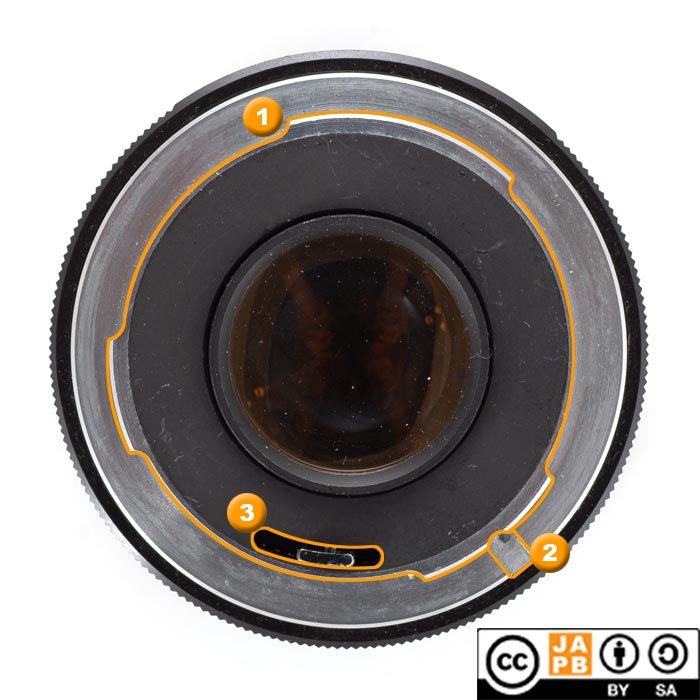Pekka Buttler (Updated 06/2025)
Yashica Pentamatic mount – Specifications and identification:
Mount type: Bayonet (lens release on body)
Flange focal distance: 43 mm
Film format: 36mm x 24mm (‘Full frame’)
Mount communication: One lever to facilitate aperture stop-down (camera-to-lens). The same lever moves to indicate the chosen aperture (but it is unclear whether Yashica had plans to use this functionality (lens-to-camera).

Key characteristics of the mount of Yashica Pentamatic lenses:
[1] Three-pronged male bayonet. All edges tapered. Locking notch at 05:00 position.
[2] Locking groove at 05:00 o’clock.
[3] Dual-purpose aperture stop-down and aperture indicator lever.
Basics of the Yashica Pentamatic mount:
At the end of the 1950s several Japanese camera manufacturers (including Canon, Minolta, Nikon, Pentax, Topcon) were launching SLR camera systems, most with their proprietary mounts. Yashica – who until then had been a major player in TLR cameras (as well as a minor player in some other photography fields) did not want to be left out. After a speedy development process (accelerated by some adroit acquisitions) Yashica launched the Pentamatic – its first SLR – in 1960. It was by no means a bad camera (even though it had some quirks), nor were the Yashica lenses subpar (even though the lineup of lenses was initially not of impressive breadth), but it did not gain traction, even though Yashica manufactured custom adapters from the most prominent competing mounts (e.g. M42 and Exakta) to the Pentamatic mount.
As Yashica’s own assessment was that the lens mount was holding the camera back, Yashica very quickly (already in 1961) launched a parallel line of cameras using the M42 thread mount. In the end, Yashica lost faith in its proprietary mount, and the Yashica Pentamatic II (launched 1962) became the last Yashica SLR to use the Pentamatic-mount. For the next dozen-some years Yashica SLRs used the M42 thread mount, until Yashica’s partnership with Carl Zeiss (west) in the launch of the Contax/Yashica mount.
Adapting Yashica Pentamatic -mount lenses:
As is typical for optics of this era, the lenses are fully manual, thus offering themselves for easy adaptation. Also, not uncommonly, adapting Pentamatic lenses for use on dSLR’s suffers the usual issues with regards to adapters and flange focal distances, as the Flange focal distance of the Pentamatic mount is shorter than that of any dSLR system Theoretically, it would be possible to use Pentamatic lenses on dSLRs, using an adapter with optics, but – to my knowledge – no-one is offering such adapters.
With mirrorless cameras, there are few technological/optical impediments to using Pentamatic lenses. The only thing needed is a suitable dumb adapter to allow you to mount your Pentamatic lenses on your mirrorless of choice. If your mirrorless is of the full-frame variety, the Pentamatic lenses will work exactly as designed, and if your mILC has a smaller-than full-frame sensor, you can use your Pentamatic lens with a crop factor. The caveat however is that – likely due to the Pentamatic mount’s relative lack of success – none of the adapter manufacturers are currently manufacturing/selling Pentamatic adapters. However, on eBay there is at least one specialised adapter maker offering adapters from Pentamatic to a wide range of mirrorless cameras.